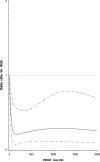Angiogenic and inflammatory biomarkers in midpregnancy and small-for-gestational-age outcomes in Tanzania
- PMID: 24881826
- PMCID: PMC4247823
- DOI: 10.1016/j.ajog.2014.05.032
Angiogenic and inflammatory biomarkers in midpregnancy and small-for-gestational-age outcomes in Tanzania
Abstract
Objective: We sought to investigate the relationship between a panel of angiogenic and inflammatory biomarkers measured in midpregnancy and small-for-gestational-age (SGA) outcomes in sub-Saharan Africa.
Study design: Concentrations of 18 angiogenic and inflammatory biomarkers were determined in 432 pregnant women in Dar es Salaam, Tanzania, who participated in a trial examining the effect of multivitamins on pregnancy outcomes. Infants falling below the 10th percentile of birthweight for gestational age relative to the applied growth standards were considered SGA. Multivariate binomial regression models with the log link function were used to determine the relative risk of SGA associated with increasing quartiles of each biomarker. Restricted cubic splines were used to test for nonlinearity of these associations.
Results: A total of 60 participants (13.9%) gave birth to SGA infants. Compared to those in the first quartile, the risk of SGA was reduced among those in the fourth quartiles of vascular endothelial growth factor-A (adjusted risk ratio [RR], 0.38; 95% confidence interval [CI], 0.19-0.74), placental growth factor (adjusted RR, 0.28; 95% CI, 0.12-0.61), soluble fms-like tyrosine kinase-1 (adjusted RR, 0.48; 95% CI, 0.23-1.01), monocyte chemoattractant protein-1 (adjusted RR, 0.48; 95% CI, 0.25-0.92), and leptin (adjusted RR, 0.46; 95% CI, 0.22-0.96).
Conclusion: Our findings provide evidence of altered angiogenic and inflammatory mediators, at midpregnancy, in women who went on to deliver SGA infants.
Keywords: angiogenesis; inflammation; small for gestational age.
Copyright © 2014 Elsevier Inc. All rights reserved.
Figures



Similar articles
-
The change in concentrations of angiogenic and anti-angiogenic factors in maternal plasma between the first and second trimesters in risk assessment for the subsequent development of preeclampsia and small-for-gestational age.J Matern Fetal Neonatal Med. 2008 May;21(5):279-87. doi: 10.1080/14767050802034545. J Matern Fetal Neonatal Med. 2008. PMID: 18446652 Free PMC article.
-
Angiogenic factor imbalance early in pregnancy predicts adverse outcomes in patients with lupus and antiphospholipid antibodies: results of the PROMISSE study.Am J Obstet Gynecol. 2016 Jan;214(1):108.e1-108.e14. doi: 10.1016/j.ajog.2015.09.066. Epub 2015 Sep 29. Am J Obstet Gynecol. 2016. PMID: 26432463 Free PMC article.
-
A longitudinal study of angiogenic (placental growth factor) and anti-angiogenic (soluble endoglin and soluble vascular endothelial growth factor receptor-1) factors in normal pregnancy and patients destined to develop preeclampsia and deliver a small for gestational age neonate.J Matern Fetal Neonatal Med. 2008 Jan;21(1):9-23. doi: 10.1080/14767050701830480. J Matern Fetal Neonatal Med. 2008. PMID: 18175241 Free PMC article.
-
Angiogenic biomarkers in pregnancy: defining maternal and fetal health.Acta Obstet Gynecol Scand. 2015 Aug;94(8):820-32. doi: 10.1111/aogs.12629. Epub 2015 Mar 31. Acta Obstet Gynecol Scand. 2015. PMID: 25753566 Review.
-
The vascular endothelial growth factor family in adverse pregnancy outcomes.Hum Reprod Update. 2012 Jul;18(4):436-57. doi: 10.1093/humupd/dms011. Epub 2012 Apr 11. Hum Reprod Update. 2012. PMID: 22495259 Review.
Cited by
-
Maternal plasma angiogenic index-1 (placental growth factor/soluble vascular endothelial growth factor receptor-1) is a biomarker for the burden of placental lesions consistent with uteroplacental underperfusion: a longitudinal case-cohort study.Am J Obstet Gynecol. 2016 May;214(5):629.e1-629.e17. doi: 10.1016/j.ajog.2015.11.015. Epub 2015 Dec 11. Am J Obstet Gynecol. 2016. PMID: 26688491 Free PMC article.
-
Biochemical tests of placental function versus ultrasound assessment of fetal size for stillbirth and small-for-gestational-age infants.Cochrane Database Syst Rev. 2019 May 14;5(5):CD012245. doi: 10.1002/14651858.CD012245.pub2. Cochrane Database Syst Rev. 2019. PMID: 31087568 Free PMC article.
-
Associations between repeated ultrasound measures of fetal growth and biomarkers of maternal oxidative stress and inflammation in pregnancy.Am J Reprod Immunol. 2018 Oct;80(4):e13017. doi: 10.1111/aji.13017. Epub 2018 Jul 8. Am J Reprod Immunol. 2018. PMID: 29984454 Free PMC article.
-
Sulphadoxine-pyrimethamine plus azithromycin may improve birth outcomes through impacts on inflammation and placental angiogenesis independent of malarial infection.Sci Rep. 2019 Feb 19;9(1):2260. doi: 10.1038/s41598-019-38821-2. Sci Rep. 2019. PMID: 30783215 Free PMC article. Clinical Trial.
-
Association of mid-trimester maternal angiogenic biomarkers with small-for-gestational-age infants in an urban Zambian cohort: a nested case-control study.Int J Gynaecol Obstet. 2022 Jun;157(3):604-612. doi: 10.1002/ijgo.13860. Epub 2021 Aug 25. Int J Gynaecol Obstet. 2022. PMID: 34358336 Free PMC article.
References
-
- Longo S, Bollani L, Decembrino L, Di Comite A, Angelini M, Stronati M. Short-term and long-term sequelae in intrauterine growth retardation (IUGR). J Matern Fetal Neonatal Med. 2013;26:222–5. - PubMed
-
- Morris RK, Oliver EA, Malin G, Khan KS, Meads C. Effectiveness of interventions for the prevention of small-for-gestational age fetuses and perinatal mortality: a review of systematic reviews. Acta Obstet Gynecol Scand. 2013;92:143–51. - PubMed
-
- Conde-Agudelo A, Papageorghiou AT, Kennedy SH, Villar J. Novel biomarkers for predicting intrauterine growth restriction: a systematic review and meta-analysis. BJOG. 2013;120:681–94. - PubMed
Publication types
MeSH terms
Substances
Grants and funding
LinkOut - more resources
Full Text Sources
Other Literature Sources
Medical
Research Materials
Miscellaneous

